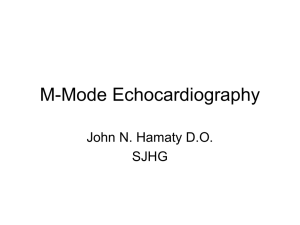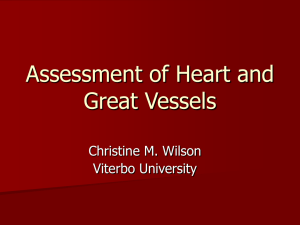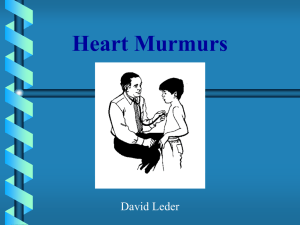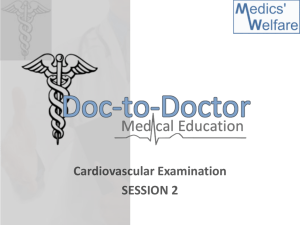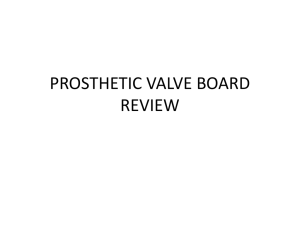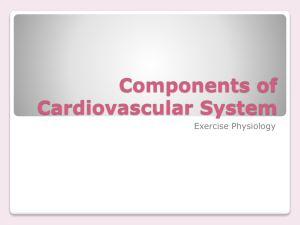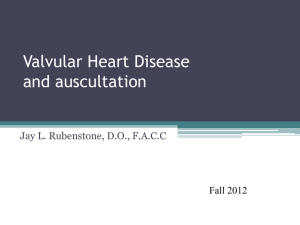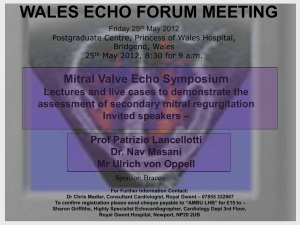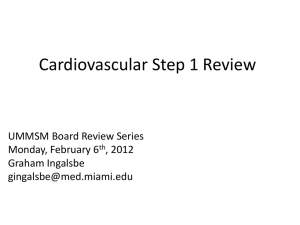Valvular Heart Disease - Nursing PowerPoint Presentations
advertisement
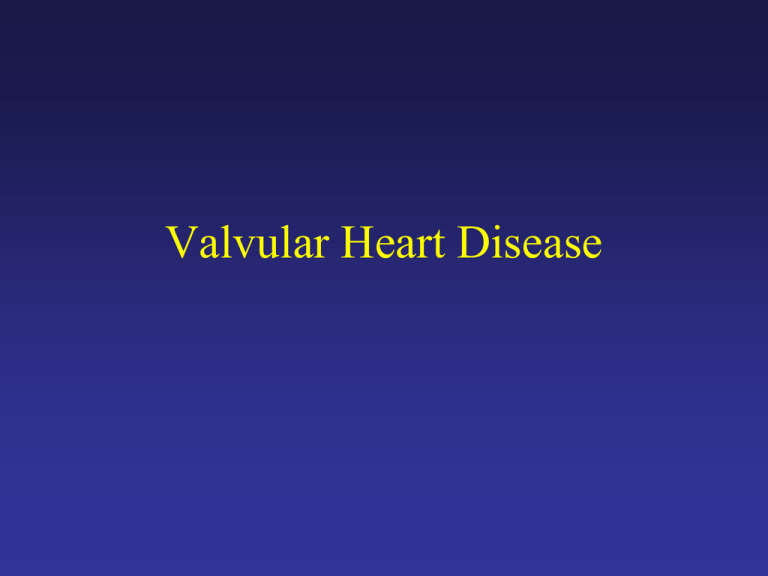
Valvular Heart Disease Types • • • • • • Mitral Stenosis Mitral Regurgitation Mitral Valve Prolapse Aortic Stenosis Aortic regurgitation Tricuspid valve is affected infrequently – Tricuspid stenosis – causes Rt HF – Tricuspid regurgitation –causes venous overload Tricuspid Valve Rheumatic Heart Disease • Inflammatory process that may affect the myocardium, pericardium and or endocardium • Usually results in distortion and scarring of the valves Rheumatic Heart Disease, cont. • Subjective symptoms – Prior history of rheumatic fever – General malaise – Pain – may or may not be present • Objective symptoms – – – – Temperature Murmurs Dyspnea polyarthritis Rheumatic Heart Disease • Diagnosis – – – – – – – – – H/P WBC and ESR C-reactive protein Cardiac enzymes EKG Chest x-ray Echo Cardiac cath Cardiac output Rheumatic Heart Disease • Nursing Care – – – – – – Vital signs Rest and quiet environment Give antibiotics, digitalis, and diuretics Provide adequate nutrition Monitor I/O Explain treatment and home care Mitral Stenosis • • • • • • • • Usually results from rheumatic carditis Is a thickening by fibrosis or calcification Can be caused by tumors, calcium and thrombus Valve leaflets fuse and become stiff and the cordae tendineae contract These narrows the opening and prevents normal blood flow from the LA to the LV LA pressure increases, left atrium dilates, PAP increases, and the RV hypertrophies Pulmonary congestion and right sided heart failure occurs Followed by decreased preload and CO decreases Mitral Stenosis, cont. • Mild – asymptomatic • With progression – dyspnea, orthopneas, dry cough, hemoptysis, and pulmonary edema may appear as hypertension and congestion progresses • Right sided heart failure symptoms occur later • S/S – Pulse may be normal to A-Fib – Apical diastolic murmur is heard Mitral Regurgitation • Primarily caused by rheumatic heart disease, but may be caused by papillary muscle rupture form congenital, infective endocarditis or ischemic heart disease • Abnormality prevents the valve from closing • Blood flows back into the right atrium during systole • During diastole the regurg output flows into the LV with the normal blood flow and increases the volume into the LV • Progression is slowly – fatigue, chronic weakness, dyspnea, anxiety, palpitations • May have A-fib and changes of LV failure • May develop right sided failure as well Mitral Valve Prolapse • Cause is variable and may be associated with congenital defects • More common in women • Valvular leaflets enlarge and prolapse into the LA during systole • Most are asymptomatic • Some may report chest pain, palpitations or exercise intolerance • May have dizziness, syncope and palpitations associated with dysrhythmias • May have audible click and murmur Aortic Stenosis • Valve becomes stiff and fibrotic, impeding blood flow with LV contraction • Results in LV hypertrophy, increased O2 demands, and pulmonary congestion • Causes – rheumatic fever, congenital, arthrosclerosis • Atherosclerosis and calcification is primary cause in the elderly • Complications – right sided heart failure, pulmonary edema, and A-fib • S/S – Early: dyspnea, angina, syncope Late: marked fatigue, debilitation, and peripheral cyanosis, crescendodecrescendo murmur is heard Aortic Regurgitation • Aortic valve leaflets do not close properly during diastole • The valve ring that attaches to the leaflets may be dilated, loose, or deformed • The ventricle dilates to accommodate the ^ blood volume and hypertrophies • Causes: infective endocarditis, congenital, hypertension, Marfan’s • May remain asymptomatic for years • Develop dyspnea, orthopnea, palpitations, ,and angina • May have ^ systolic pressure with bounding pulse • Have a high pitch, blowing, decrescendo diastolic murmur Assessment for Valve Dysfunction • Subjective symptoms – – – – – – – – Fatigue Weakness General malaise Dyspnea on exertion Dizziness Chest pain or discomfort Weight gain Prior history of rheumatic heart disease Assessment, cont. • Objective symptoms – – – – – – – – – Orthopnea Dyspnea, rales Pink-tinged sputum Murmurs Palpitations Cyanosis, capillary refill Edema Dysrhythmias Restlessness Diagnosis • • • • • History and physical findings EKG Chest x-ray Cardiac cath Echocardiogram Medial Treatment • Nonsurgical management focuses on drug therapy and rest • Diuretic, beta blockers, digoxin, O2, vasodilators, prophylactic antibiotic therapy • Manage A-fib, if develops, with conversion if possible, and use of anticoagulation Interventions • • • • • • • • • Assess vitals, heart sounds, adventitious breath sounds ^ HOB O2 as prescribed Emotional support Give medications I/O Weight Check for edema Explain disease process, provide for home care with O2, medications Surgical Management of Valve Disease • Mitral Valve – Commissurotomy – Mitral Valve Replacement – Balloon Valvuloplasty • Aortic Valve Replacement Mechanical Valve Mechanical Valve Porcine Valve Tissue Valve Tissue Valve Cardiac murmurs • Cardiac murmurs are often the first sign of underlying valvular disease. • May be systolic or diastolic, pathological or benign. • Systolic murmurs may be due to physiological increases in blood velocity or might indicate as yet asymptomatic cardiac disease. • Diastolic murmurs are almost always pathological and require further evaluation. • An ECG and CXR, although readily available tests, provide limited diagnostic information. Echocardiography Echocardiography can evaluate valve function by the following imaging modalities: • 2-D: Valve motion and morphology; LV size and function. • Doppler: Blood flow velocity; valve gradients; haemodynamic data. • Colour flow: Valvular regurgitation Management of cardiac murmurs • Murmur + cardiac symptoms: refer to cardiologist. • In asymptomatic patients with cardiac murmurs, an echo is indicated in the following instances: - Murmur + abnormal cardiac signs Murmur + abnormal ECG or CXR Diastolic or continuous murmurs Pansystolic or late systolic murmurs Aortic stenosis Aetiology • Aortic stenosis may be congenital or acquired. • Congenital malformations may be tricuspid, bicuspid or unicuspid. • Acquired causes include the following: - Degenerative disease Rheumatic disease Calcific e.g. end-stage renal failure, Paget’s disease Miscellaneous e.g. rheumatoid involvement Aetiology of aortic stenosis A: Normal aortic valve B: Congenital aortic stenosis C: Rheumatic aortic stenosis D: Calcific aortic stenosis E: Degenerative aortic stenosis Aortic stenosis Grading and severity • Aortic valve area must be reduced to 25% of normal before significant circulatory changes occur. • Grading of stenosis severity is as follows: Normal valve area = 3-4cm2 Mild stenosis = 1.5-3cm2 Moderate stenosis = 1.0-1.5cm2 Severe stenosis ≤ 1.0cm2 • When stenosis is severe, the peak gradient across the aortic valve is usually > 60mmHg. Pathophysiology of aortic stenosis Aortic stenosis LV outflow obstruction LV systolic pressure Aortic pressure LV hypertrophy LV dysfunction Myocardial ischaemia LV failure Aortic stenosis Natural history of aortic stenosis without operative treatment: Aortic stenosis Physical findings • • • • • • Slow rising pulse Reduced systolic and pulse pressure Systolic thrill over the aortic area Ejection systolic, crescendo-decrescendo murmur Soft or inaudible second heart sound ECG: LVH, AV node conduction defects Aortic stenosis Medical therapy • Conservative treatment should be offered for mild to moderate aortic stenosis and to asymptomatic patients with severe aortic stenosis as follows: - Advise to report symptoms Avoid vigorous exercise Antibiotic prophylaxis for endocarditis Regular follow-up ± echocardiography Aortic stenosis Surgical therapy • Aortic valve replacement should be offered to the following: - Symptomatic pts with severe AS Pts with severe AS undergoing CABG surgery Pts with moderate AS undergoing CABG surgery Asymptomatic pts with severe AS and LV dysfunction • Balloon valvuloplasty can play a temporary role as a bridge to surgery in haemodynamically unstable patients, or as palliation for patients with serious comorbid conditions Aortic stenosis Aortic valve replacement • In the absence of LV dysfunction, operative risk is 2-8%. • Indicators of higher mortality are NYHA class, LV dysfunction, age, concomitant coronary artery disease, and aortic regurgitation. • Valve replacement usually results in reduced LV volumes, improved LV performance and regression of LV hypertrophy. Aortic regurgitation Aetiology • Either due to primary disease of the aortic valve or wall of the aortic root or both. • Causes of primary aortic valve disease include: Congenital eg. bicuspid aortic valve Acquired: rheumatic valve disease, infective endocarditis, trauma, connective tissue disease. • Causes of primary aortic root disease include: Degenerative, cystic medial necrosis (eg. Marfan’s), aortic dissection, syphilis, connective tissue disease, hypertension. Pathophysiology of aortic regurgitation Aortic regurgitation LV volume stroke volume LV mass systolic BP LV dysfunction diastolic BP myocardial ischaemia LV failure Aortic regurgitation Clinical history • In chronic severe AR, the left ventricle gradually enlarges while the patient remains asymptomatic. Symptoms usually develop after cardiomegaly and LV dysfunction have occurred. Dyspnoea is the principal complaint. Syncope is rare and angina is less frequent than in aortic stenosis. • In acute severe AR, LV decompensation occurs readily with fatigue , severe dyspnoea and hypotension. Aortic regurgitation Physical findings • Collapsing pulse. • Wide pulse pressure due to both raised systolic blood pressure and reduced diastolic blood pressure. • Displaced, diffuse and hyperdynamic apex beat. • Early blowing diastolic murmur. • ECG: Left axis deviation, LV hypertrophy. • CXR: Cardiomegaly, aortic calcification, aortic root dilatation. Aortic regurgitation Management • Medical treatment includes: Diuretics, digoxin, salt restriction Vasodilators Endocarditis prophylaxis • Indications for surgical treatment depend on symptoms, and LV size and function. • Without surgery, death usually occurs within 4 years of developing angina and within 2 years after onset of heart failure. Aortic regurgitation Surgical therapy • Severe acute AR requires prompt surgical intervention. • Indications for valve replacement in pure, severe, chronic AR include: Symptomatic patients with normal LV function Symptomatic patients with LV dysfunction or dilatation Asymptomatic patients with LV dysfunction or dilatation (EF<50% or end-systolic diameter > 55mm) • Aortic valve and root replacement are indicated in patients with disease of the proximal aorta and AR of any severity when the aortic root diameter is ≥ 50mm. Aortic valve replacement and prognosis Relation of preoperative LV function to postoperative survival Mitral stenosis Aetiology • Rheumatic fever is the predominant cause. • Rarely, mitral stenosis is congenital and observed almost exclusively in infants and young children. • Miscellaneous rare causes include carcinoid, SLE, rheumatoid arthritis and mucopolysaccharidoses. • Causes of left atrial outflow obstruction that may simulate mitral stenosis include left atrial myxoma, ball-valve thrombus, infective endocarditis with large vegetation and cor triatriatum. Rheumatic mitral stenosis • Rheumatic mitral stenosis is due to four forms of fusion: commissural (30%), cuspal (15%), chordal (10%) or combined (45%). • The stenotic mitral valve is typically funnel-shaped; the orifice is frequently shaped like a fish mouth. • Symptoms usuually occur in the 3rd or 4th decade, but mild MS in the aged is becoming more common. • 25% of patients with rheumatic mitral valve disease have pure mitral stenosis and two-thirds are female. • May be associated with an atrial septal defect – Lutembacher’s syndrome. Mitral stenosis Pathophysiology • Normal mitral valve area = 4-6cm2. • Usually, a mitral valve area ≤ 2.5cm2 must occur before the development of symptoms. • A mitral valve area >1.5cm2 usually does not produce symptoms at rest. • The first symptoms in mild mitral stenosis are usually precipitated by exercise, emotional stress, infection, pregnancy or fast atrial fibrillation. • A mitral valve area ≤ 1cm2 equates to severe mitral stenosis. • Pulmonary hypertension results from backward pressure, pulmonary arteriolar constriction and organic obliterative changes in the pulmonary vascular bed. Mitral stenosis Natural history • Long latent period of 20 to 40 years from the occurrence of rheumatic fever to onset of symptoms. • Once symptoms develop, there is a further 10 years before symptoms become disabling. • Once significant limiting symptoms occur, the 10year survival rate is 5-15%. • When there is severe pulmonary hypertension, mean survival falls to < 3 years. • Mortality from untreated mitral stenosis is due to progressive heart failure (60-70%), systemic embolism (20-30%) and pulmonary embolism (10%). Mitral stenosis Clinical features • The main symptom is dyspnoea due to reduced lung compliance. • Haemoptysis may also occur. • Approximately 15% of patients experience angina due to either coincidental coronary artery disease, right ventricular hypertension or coronary embolisation. • Embolic events may occur and 80% of such patients are in atrial fibrillation. Mitral stenosis Physical findings • Mitral facies – pinkish-purple patches on the cheeks. • Tapping apex beat – palpable first heart sound. • Right ventricular heave, loud P2 indicating pulmonary hypertension. • Loud first heart sound. • Opening snap. • Rumbling, mid-diastolic murmur with presystolic accentuation in sinus rhythm. Mitral stenosis Echo evaluation • Assessment of valve morphology: degree of leaflet thickness, mobility and calcification and extent of subvalvular fusion. • Estimation of left atrial size. • Doppler echo: estimation of mitral valve area, transvalvular gradient and PA pressure. Mitral stenosis Medical treatment • The asymptomatic patient with mild mitral stenosis should be managed medically. Medical therapy includes: - Avoidance of unusual physical stress. - Salt restriction. - Diuretics if needed. - Control of heart rate – β-blocker or digoxin. - Anticoagulation for AF or prior embolic event. - Annual follow-up. - Echocardiography if deterioration in clinical condition. Mitral stenosis Management of symptomatic mitral stenosis • Patients with symptoms should undergo clinical reevaluation with echocardiography. • NYHA class II symptoms and mild mitral stenosis may be managed medically. • NYHA class II symptoms and at least moderate stenosis (MVA≤1.5cm2 or mean gradient ≥5mmHg) may be considered for balloon valvuloplasty. • NYHA class III or IV symptoms and severe mitral stenosis should be considered for balloon valvuloplasty or surgery. Mitral stenosis Balloon mitral valvuloplasty • The technique involves passing a balloon flotation catheter across the interatrial septum after trans-septal puncture and dilating the balloon within the mitral valve orifice. • Results of the procedure are highly dependent on the experience of the operator. • 80-95% of patients have a successful procedure. • Complications include severe MR, residual ASD, myocardial perforation, emboli, MI and death. • Overall event-free survival is 50% to 65% over 3-7 years. • The underlying mitral valve morphology is the most important factor in determining outcome. • Relative contraindications include the presence of a left atrial thrombus and significant mitral regurgitation. Mitral stenosis Mitral valve replacement • Mitral valve replacement is indicated in patients with severe mitral stenosis and contraindications to surgical commisurotomy or balloon valvuloplasty: - Restenosis following surgical commisurotomy or balloon valvuloplasty. - Significant mitral stenosis and regurgitation. - Extensive calcification of the subvalvular apparatus. • Operative mortality ranges from 3-8% in most centres. • Postponement of surgery until the patient reaches NYHA class IV symptoms should be avoided. Mitral regurgitation Aetiology Mitral regurgitation may be caused by abnormalities of the valve leaflets, chordae tendinae, papillary muscles or mitral annulus: • Valve leaflets - myxomatous degeneration causing mitral valve prolapse - shortening, rigidity, deformity and retraction due to rheumatic heart disease - vegetations due to infective endocarditis • Chordae tendinae - congenital, infective endocarditis, trauma, rheumatic fever, myxomatous • Papillary muscles - myocardial ischaemia, congenital abnormalities, infiltrative disease • Mitral annulus - dilatation eg. ischaemic or dilated cardiomyopathy - calcification due to degeneration, hypertension, aortic stenosis, diabetes, chronic renal failure Mitral regurgitation Clinical features • Symptoms usually occur with LV decompensation: dyspnoea and fatigue. • Physical findings include: • - Pulse: sharp upstroke • - Apex: displaced, hyperdynamic • - Heart sounds: pansystolic murmur loudest at the apex, radiating to the axilla and accentuated by expiration. Mitral regurgitation Natural history • The natural history of chronic MR depends on the volume of regurgitation, the state of the myocardium and the underlying cause. • Preoperative LV end-systolic diameter is a useful predictor of postoperative survival in chronic MR. • The preoperative LV end-systolic diameter should be < 45mm to ensure normal postoperative LV function. Mitral regurgitation Medical treatment • Symptomatic patients may benefit from the following drug therapy whilst awaiting surgery: • Vasodilator therapy • Diuretics • Digoxin / Beta-blockers in presence of atrial fibrillation. • Endocarditis prophylaxis Mitral regurgitation Surgical treatment • Surgery is indicated in the presence of symptoms or left ventricular end systolic diameter ≥45mm. • The surgical procedure consists of either mitral valve repair or replacement. • Mitral valve repair better preserves LV function and avoids the need for chronic anticoagulation. • However, mitral valve repair is technically more demanding and often not possible to perform in severely deformed valves. Mitral regurgitation Relationship of preoperative ejection fraction to postoperative survival Acute mitral regurgitation Aetiology Important causes of acute mitral regurgitation include: • Infective endocarditis causing disruption of valve leaflets or chordal rupture. • Ischaemic dysfunction or rupture of papillary muscle. • Malfunction of prosthetic valve. Chronic versus Acute MR Finding Chronic MR Symptoms Appearance subtle onset normal/mildly dyspnoeic not striking displaced common harsh pansystolic Tachycardia Apex beat Systolic thrill Murmur ECG-LVH CXR usually present severe cardiomegaly Acute MR obvious severely ill always present not displaced absent soft or absent early systolic component absent normal heart size Acute mitral regurgitation Medical therapy The following therapies may be beneficial in reducing the severity of MR - Vasodilator therapy - Inotropic therapy - Intra-aortic balloon counterpulsation Surgical therapy • Indicated in patients with acute severe MR and heart failure. • Higher mortality rates than for elective chronic MR, but unless treated aggressively, the outcome is usually fatal. Mitral valve prolapse General features • • • • Occurs in 2-6% of the general population Twice as common in women. Due to myxomatous proliferation of the mitral valve. Usually occurs as a primary condition, but may be a secondary finding in connective tissue diseases e.g. Marfan’s syndrome. • Vast majority of patients are asymptomatic. • Symptoms may include palpitations, dizziness, syncope, or chest discomfort. • The principal physical finding is the mid-systolic click, followed by a late systolic murmur in the presence of regurgitation. Mitral valve prolapse Echocardiographic criteria • M-mode criterion: 2mm posterior displacement of one or both leaflets. • 2-D echo findings: Systolic displacement of one or both leaflets within the left atrium in the parasternal long-axis view; leaflet thickening, redundancy, chordal elongation and annular dilatation. • The diagnosis of mitral valve prolapse is even more certain when leaflet thickness is >5mm. • Echocardiography is useful in the risk stratification of patients with mitral valve prolapse. Mitral valve prolapse Natural history • In most patients, mitral valve prolapse is associated with a benign prognosis. • Complications may occur in patients with a systolic murmur, thickened leaflets an increased LV or LA size, especially in men > 45 years old: • Complications include progressive mitral regurgitation, infective endocarditis, cerebral emboli, arrhythmias and rarely sudden death. Mitral valve prolapse Management • Asymptomatic patients without MR or arrhythmias have an excellent prognosis – follow-up every 3-5 years. • Patients with a typical systolic murmur should receive endocarditis prophylaxis. • Patients with a long systolic murmur may show progression of MR and should be reviewed annually. • Patients with previous embolic events should be given antiplatelet / anticoagulant therapy. • Severe MR requires surgery, often mitral valve repair. Prosthetic valves Prosthetic valves may be divided into 2 broad categories: Mechanical valves • Very good durability. • Require long-term anticoagulation. • May cause mild haemolysis. Bioprosthetic (tissue) valves • Porcine variety most commonly used. • Limited durability. • Anticoagulation for first 3 months only. Mechanical valves Designs and flow patterns of different types of mechanical valves Prosthetic valves Mechanical versus tissue valves • No difference in survival, haemodynamics or in probability of developing endocarditis, valve thrombosis or systemic embolism. • Valve-related failure is much more common with tissue valves. • Anticoagulant-related bleeding occurs with mechanical valves. • Elderly patients tend to receive tissue valves. Tricuspid stenosis • Always rheumatic in origin and when present accompanies mitral valve involvement. • The anatomical changes and physiological principles are similar to those of mitral stenosis. • The low cardiac output state causes fatigue; abdominal discomfort may occur due to hepatomegaly and ascites. • The diastolic murmur of tricuspid stenosis is augmented by inspiration. • Medical management includes salt restriction and diuretics. • Surgical treatment should be carried out in patients with a valve area <2.0cm2 and a mean pressure gradient >5mmHg. Tricuspid reurgitation • Most common cause is annular dilatation due to RV failure of any cause; may also be caused by intrinsic valve involvement • Well tolerated in the absence of pulmonary hypertension; in the presence of pulmonary hypertension, cardiac output declines and RV failure may worsen. • Symptoms and signs result from a reduced cardiac output, ascites, painful congestive hepatomegaly and oedema. • The pansystolic murmur of TR is usually loudest at the left sternal edge and augmented by deep inspiration. • Severe functional TR may be treated by annuloplasty or valve replacement. Severe TR due to intrinsic tricuspid valve disease requires valve replacement. Pulmonary stenosis • Most commonly due to congenital malformation and usually an isolated anomaly. • Survival into adulthood is the rule, infective endocarditis is a risk and right ventricular failure is the most common cause of death. • Rheumatic involvement of the pulmonary valve is very uncommon and rarely leads to serious deformity. • Carcinoid plaques may lead to constriction of the pulmonary valve ring. Pulmonary regurgitation • Most common cause is ring dilatation due to pulmonary hypertension, or dilatation of the pulmonary artery secondary to a connective tissue disorder. • May be tolerated for many years unless complicated by pulmonary hypertension. • The clinical manifestations of the primary disease tend to overshadow the pulmonary regurgitation. • Physical examination reveals a right ventricular heave and a high-pitched, blowing, early diastolic decrescendo murmur over the left sternal edge, augmented by deep inspiration. • Pulmonary regurgitation is seldom severe enough to require specific treatment. Surgery may be required because of intractable RV failure.
